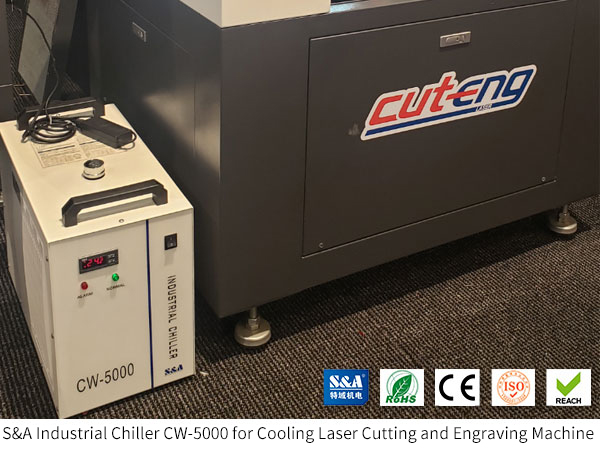![Marcatura laser è incisione laser, sò listessi? 1]()
Spessu a ghjente cunsidereghja a marcatura laser è l'incisione laser cum'è a listessa cosa. In fatti, sò ligeramente sfarenti.
Ancu s'è a marcatura laser è l'incisione laser utilizanu u laser per lascià marchi incancellabili nantu à i materiali, l'incisione laser face evaporà i materiali, mentre chì a marcatura laser face scioglie i materiali. A superficia di u materiale in fusione si espanderà è formerà una sezione di trincea di 80 µm di prufundità, chì cambierà a rugosità di u materiale è formerà un cuntrastu biancu è neru. Quì sottu discuteremu i fattori chì influenzanu u cuntrastu biancu è neru in a marcatura laser.
3 Passi di marcatura laser
(1) Passu 1: U raghju laser agisce nantu à a superficia di u materiale
Ciò chì a marcatura laser è l'incisione laser anu in cumunu hè chì u raghju laser hè impulsivu. Vale à dì, u sistema laser injecterà un impulsu dopu un certu intervallu. Un laser di 100 W pò injectà 100 000 impulsi ogni seconda. Dunque, pudemu calculà chì l'energia di un unicu impulsu hè 1 mJ è u valore di piccu pò ghjunghje à 10 KW.
Per cuntrullà l'energia laser chì agisce nantu à u materiale, hè necessariu aghjustà i parametri di u laser. È i parametri i più impurtanti sò a velocità di scansione è a distanza di scansione, per questi dui decide l'intervallu di dui impulsi di adiacenza chì agisce nantu à u materiale. Più vicinu hè l'intervallu di l'impulsi di adiacenza, più energia serà assorbita.
In paragone cù l'incisione laser, a marcatura laser richiede menu energia, dunque a so velocità di scansione hè più rapida. Quandu si decide di sceglie trà incisione laser o marcatura laser, a velocità di scansione hè un parametru decisivu.
(2) Passu 2: U materiale assorbe l'energia laser
Quandu u laser travaglia nantu à a superficia di u materiale, a maiò parte di l'energia laser serà riflessa da a superficia di u materiale. Solu una piccula parte di l'energia laser hè assorbita da i materiali è si trasforma in calore. Per fà evaporà u materiale, l'incisione laser richiede più energia, ma a marcatura laser richiede solu menu energia per fonde i materiali.
Una volta chì l'energia assorbita si trasforma in calore, a temperatura di u materiale aumenterà. Quandu ghjunghje à u puntu di fusione, a superficia di u materiale si fonderà per furmà cambiamenti.
Per un laser di lunghezza d'onda di 1064 mm, hà un tassu d'assorbimentu di circa 5% per l'aluminiu è più di 30% per l'acciaiu. Questu face pensà à a ghjente chì l'acciaiu hè più faciule da marcà cù laser. Ma ùn hè micca u casu. Avemu ancu bisognu di pensà à altre caratteristiche fisiche di i materiali, cum'è u puntu di fusione.
(3) Passu 3: A superficia di u materiale avarà una espansione lucale è un cambiamentu di rugosità.
Quandu u materiale si fonde è si raffredda in parechji millisecondi, a rugosità di a superficia di u materiale cambierà per furmà una marcatura permanente chì include u numeru di serie, forme, logò, ecc.
Marcatura di diversi mudelli nantu à a superficia di u materiale purterà ancu à un cambiamentu di culore. Per a marcatura laser di alta qualità, u cuntrastu biancu è neru hè u megliu standard di prova.
Quandu a superficia di u materiale ruvida hà una riflessione diffusa di a luce incidente, a superficia di u materiale apparerà bianca;
Quandu a superficia ruvida di u materiale assorbe a maiò parte di a luce incidente, a superficia di u materiale apparerà nera.
Mentre per l'incisione laser, l'impulsu laser à alta densità d'energia funziona nantu à a superficia di u materiale. L'energia laser si trasforma in calore, trasfurmendu u materiale da u statu solidu à u statu gaseosu per rimuovere a superficia di u materiale.
Dunque, sceglite a marcatura laser o l'incisione laser?
Dopu avè cunnisciutu a differenza trà a marcatura laser è l'incisione laser, a prossima cosa da cunsiderà hè di decide quale sceglie. È ci vole à cunsiderà 3 fattori.
1. Resistenza à l'abrasione
L'incisione laser hà una penetrazione più prufonda chè a marcatura laser. Dunque, se u pezzu di travagliu deve esse adupratu in un ambiente chì implica abrasione o richiede un post-trattamentu cum'è a sabbiatura abrasiva superficiale o u trattamentu termicu, hè cunsigliatu di utilizà l'incisione laser.
2. Velocità di trasfurmazione
In paragone cù l'incisione laser, a marcatura laser hà una penetrazione menu prufonda, dunque a velocità di trasfurmazione hè più alta. Sè l'ambiente di travagliu induve hè aduprata a pezza di travagliu ùn implica micca abrasione, hè cunsigliatu di utilizà a marcatura laser.
3. Compatibilità
A marcatura laser fonderà u materiale per furmà parti ligeramente irregulari, mentre chì l'incisione laser farà evaporà u materiale per furmà una scanalatura. Siccomu l'incisione laser richiede abbastanza energia laser per fà chì u materiale ghjunghji à a temperatura di sublimazione è poi evapore in parechji millisecondi, l'incisione laser ùn pò esse realizata in tutti i materiali.
Da a chiarificazione sopra, pensemu chì avà avete una megliu cunniscenza di l'incisione laser è di a marcatura laser.
Dopu avè decisu quale sceglie, a prossima cosa hè di aghjunghje un refrigeratore efficace. I refrigeratori industriali S&A sò specificamente fatti per diversi tipi di macchine di marcatura laser, macchine per incisione laser, macchine per taglio laser, ecc. I refrigeratori industriali sò tutti unità autonome senza alimentazione d'acqua esterna è a putenza di raffreddamentu varia da 0,6 KW à 30 KW, abbastanza putente per raffreddà u sistema laser da una piccula putenza à una putenza media. Scoprite i mudelli cumpleti di refrigeratori industriali S&A à https://www.teyuchiller.com/products
![Refrigeratore Industriale CW 5000 per u Raffreddamentu di a Macchina di Taglio è Incisione Laser]()












































































































